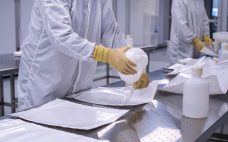Host-cell proteins (HCPs) must be assessed early in biopharmaceutical product development to establish the efficiency of a purification process. Liquid chromatography coupled with mass spectrometry (LC-MS) is a strong orthogonal method for HCP identification and quantitation. During an 18 March 2021 “Ask the Expert” presentation, Christina Morris (senior scientist at BioPharmaSpec) explained how MS analyses can enhance process development (PD), then presented considerations for generating spectral libraries, selecting samples for quantitation, and reviewing data. Morris’s Presentation Spectral Libraries: A typical…
Sponsored Content
Mixed-Mode Chromatography: Optimizing Target Purity and Recovery with Buffer Additives
This webcast features: Xuemei He, PhD, R&D Manager of Chromatography Media Chemistry, Bio-Rad Laboratories New biotherapeutic constructs continue to increase in biopharmaceutical development, extending treatment options to a broad range of diseases we face today. These biopharmaceuticals include recombinant proteins, monoclonal antibodies, antibody drug conjugates, bispecifics, viruses, and virus-like particles to mention a few. A simple, straightforward approach to the production of these biomolecules is required to meet the current demand for process efficiency and economics. Innovative chromatographic methods facilitate…
Single-Use Systems for Storing and Shipping Frozen Drug Materials
Using presterilized, single-use freeze–thaw systems instead of traditional freeze–thaw platforms that include stainless-steel tanks and bottles can help biomanufacturers manage the quality of their drug substances. Single-use assemblies reduce the risk of cross-contamination, simplify dispensing, and decrease the number of manual interventions during freezing, thawing, handling, and shipping. However, implementing a freeze–thaw process requires careful testing of the physical and thermal properties of single-use systems and related aseptic connectors as well as assessment of drug-substance quality and stability. Such evaluation…
Inducible Secretion with ESETEC: The Solution for Difficult-to-Produce Proteins
This webcast features: Dr. Marcel Thoen, Head of Global Competence Center for Cell Line Development, Wacker Biotech Escherichia coli is the most popular expression system for all nonglycosylated biopharmaceuticals. However, common challenges include purification of expressed proteins recovered from the periplasm or those needing refolding from inclusion bodies. These constraints have been addressed by the unique secretion E. coli expression system ESETEC (E. coli secretion technology) developed by Wacker Biotech. Through years of experience, Wacker Biotech has observed that secretion…
Tools for Simplifying MSC Expansion, Cryopreservation, and DMSO Removal
This webcast features: Hilary Sherman, Senior Scientist, Corning Life Sciences Mesenchymal stem cells (MSCs) are one of the most frequently utilized cell types for cell therapy applications due to their ability to be isolated from several sources and easy adaptability to culture conditions. Bone marrow derived MSCs in particular are commonly studied due to their ease of access and achievable therapeutic dosage. While expanding MSCs to achieve these quantities, there is a risk for heterogeneity-induced quality failures during the manufacturing…
Predicting Viral Clearance in Downstream Process Development
As viruses can arise during the manufacture of biopharmaceuticals, regulatory agencies require viral clearance validation studies for each biopharmaceutical prior to approval. These studies are typically conducted in biosafety level (BSL)-2 facilities and require large capital and human resources. The use of an accurate, economical, and quantifiable noninfectious viral surrogate would enable downstream purification scientists to study viral clearance throughout process development. This report explores the use of a BSL-1 compatible, noninfectious MVM particles to predict viral clearance results over…
The Unique Benefits of Presterilized Fluoropolymer Bottles: Case Studies in Vaccine Delivery Applications
This webcast features: Eric Isberg, Vice President, Life Sciences, Savillex Fluoropolymers are the ultimate materials for use in bioprocess applications, providing increased purity, compatibility, inertness, and security for process fluids and bulk product. Bottles and vials manufactured from fluoropolymers have the added benefits of having virtually no leachables and extractables, a very wide service temperature range including performance down to liquid nitrogen temperatures, and unmatched durability, including being essentially unbreakable during use. This presentation will highlight the benefits of presterilized…
Early Selection of Optimal Clones Made Easy: A New, High-Throughput, All-in-One Solution for Mannose Glycans Screening and Assessment of Critical Quality Attributes
Glycosylation is a critical quality attribute (CQA) and imparts properties such as stability, folding, solubility, cell-cell interaction and adhesion to proteins. Antibody glycosylation for example is critical due to the role carbohydrates play in modulating effector functions which affect safety and efficacy of therapeutic antibodies. The NEW Octet® GlyM Kit is designed to provide cell line development and upstream bioprocessing Octet® users with a ready to use kit for the rapid screening of % mannose content of purified and cell…
Technologies and Innovations: A Discussion with Selexis SA
Pierre-Alain Girod is chief scientific officer (CSO) for Selexis SA. He holds a PhD in plant biochemistry from the University of Lausanne in Switzerland and completed a postdoctoral fellowship at the University of Wisconsin in Madison, WI, on the degradation of proteins by the ubiquitin pathway. Girod returned to Switzerland in 1993, where he discovered a family of sequences that are involved in the epigenetic regulation of genes. That discovery subsequently has been used to express therapeutic proteins in the…
Expanding the Flow Cytometry Toolkit with Next-Generation Polymer Dyes
Since the emergence of SARS-CoV-2, scientists have discovered more about the role of our immune systems and cytokine-associated processes responsible for systemic immune reactions that are typical in patients with COVID-19 (1). Flow cytometry is used to understand those processes at a single-cell level. It is the standard method used in immunology to characterize multiple phenotypic and functional parameters of single cells, including cytokine analysis. Despite advances in flow cytometry instrumentation, reagents, and analytical software, several challenges remain. Conjugated antibodies…









